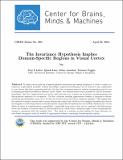| dc.contributor.author | Leibo, Joel Z | |
| dc.contributor.author | Liao, Qianli | |
| dc.contributor.author | Anselmi, Fabio | |
| dc.contributor.author | Poggio, Tomaso | |
| dc.date.accessioned | 2015-12-10T17:44:01Z | |
| dc.date.available | 2015-12-10T17:44:01Z | |
| dc.date.issued | 2015-04-26 | |
| dc.identifier.uri | http://hdl.handle.net/1721.1/100168 | |
| dc.description.abstract | Is visual cortex made up of general-purpose information processing machinery, or does it consist of a collection of specialized modules? If prior knowledge, acquired from learning a set of objects is only transferable to new objects that share properties with the old, then the recognition system’s optimal organization must be one containing specialized modules for different object classes. Our analysis starts from a premise we call the invariance hypothesis: that the computational goal of the ventral stream is to compute an invariant-to-transformations and discriminative signature for recognition. The key condition enabling approximate transfer of invariance without sacrificing discriminability turns out to be that the learned and novel objects transform similarly. This implies that the optimal recognition system must contain subsystems trained only with data from similarly-transforming objects and suggests a novel interpretation of domain-specific regions like the fusiform face area (FFA). Furthermore, we can define an index of transformation-compatibility, computable from videos, that can be combined with information about the statistics of natural vision to yield predictions for which object categories ought to have domain-specific regions. The result is a unifying account linking the large literature on view-based recognition with the wealth of experimental evidence concerning domain-specific regions. | en_US |
| dc.description.sponsorship | This work was supported by the Center for Brains, Minds & Machines
(CBMM), funded by NSF STC award CCF - 1231216. | en_US |
| dc.language.iso | en_US | en_US |
| dc.publisher | Center for Brains, Minds and Machines (CBMM), bioRxiv | en_US |
| dc.relation.ispartofseries | CBMM Memo Series;004 | |
| dc.rights | Attribution-NonCommercial 3.0 United States | * |
| dc.rights.uri | http://creativecommons.org/licenses/by-nc/3.0/us/ | * |
| dc.subject | Invariance | en_US |
| dc.subject | Computer vision | en_US |
| dc.subject | Machine Learning | en_US |
| dc.title | The Invariance Hypothesis Implies Domain-Specific Regions in Visual Cortex | en_US |
| dc.type | Technical Report | en_US |
| dc.type | Working Paper | en_US |
| dc.type | Other | en_US |
| dc.identifier.citation | http://dx.doi.org/10.1101/004473 | en_US |
